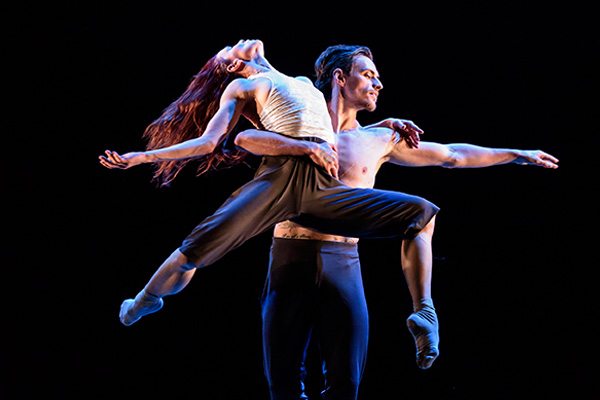She’s one of the best ballet dancers in the world. So is he. Together, they are a Russian power couple – both having met while dancing Giselle and her probably being the one to have been able to bring him back into the folds of the Royal Ballet.
He’s the bad boy, she’s the poster ballet girl. And quite unlike the Avril Lavigne song, she did not say “see ya later boy”. At first glance, it’s obvious that we have the dichotomy of them both sharing such a deep similarity, and yet we are also drawn to their classic love story nuances.
She’s Natalia Osipova, he’s Sergei Polunin, and although the show is called Natalia Osipova and Friends, it’s pretty obvious that a lot of people came specifically for the two of them.
Osipova and Polunin perform together for the first and third acts, which are two completely different dances.
Each act is a different piece commissioned by Osipova from a different choreographer, so expect neither continuity nor connection between any of them. And because of that, each of the pieces held very different experiences for me.
The first act is strongly narrative-driven: a girl falls in love with a bad boy (who is obviously dressed to be a cross between James Dean and a T-Bird), he overdoses on heroin, she gets depressed, then she dances with his ghost. As one fellow reviewer said to me after it, it was a cliché. My issue with it was the fact that Osipova’s ballet background just kept punctuating her movements in a way that made it obvious modern dance was not her usual realm: the continuous lack of letting go, the pointed feet, the all-too-perfect spins. It’s not that Osipova and Polunin didn’t have chemistry on-stage, it’s the fact that the way the choreographer (Arthur Pita) didn’t manage to create movements that pushed her out of her comfort zone.
The third act is by Russell Maliphant, who took a completely different approach for accommodating Osipova’s style: instead of trying to disguise and pass off her ballet movements as modern dance, Maliphant takes a more fusion approach. It’s not just the classic ballet pirouettes and piqué turns, he adds in elements of paso doble and capoeira in a dance that depicts the meeting of two spirits. Although rather gimmicky at points – when the dancers spin across the stage, their arms cut through the light beam, making them look like spinning tops – it is well-constructed. The soundtrack is atrocious: I’ve had enough of watching dances begin with solitary low notes to ground the piece, I’ve had enough of people adding beats to classical instruments and styles to make it more modern, and please just stop so obviously trying to manipulate our emotions. About two-thirds of the way through, I tuned out the music (if you could call it that), and suddenly, the dance was ten times better. I suggest putting in earplugs if you want to really appreciate Osipova and Polunin’s dancing in this act.
The best act, by far, was the second – and Polunin wasn’t even dancing in it. This is where the ‘guests’ in Natalia Osipova and Guests come in. It’s a trio of dancers, but one body. Sidi Larbi Cherkouai’s vision for this piece was of an apocalyptic landscape, and a statement of survival. Entitled Qutb, it’s the sort of modern dance that makes you squirm a bit in your seat. In a good way. It’s bleak, it’s difficult (you’ll understand when you see it), and there really isn’t any catharsis at any point.
The most glorious parts of his act are Jason Kittelberger and James O’Hara, whose freedom and uninhibited movements make for powerful expressions. The majority of the performance had me wondering if it was about life or death, but it didn’t seem to go either of those directions. If anything, the dance suggested more of a rebirth situation, a redemption of some kind for the human race. For those of you who saw his last work, Babel (words), when it last came to Auckland, this would come of no surprise to you.
The great thing about Cherkouai is that he has decided to basically break Osipova of her ballet relexes. She’s made to move slower, and in arcs, moving with more gravitas and pathos. Maybe it’s because he understands the drilling of ballet dancers’ bodies in a way Pita and Maliphant don’t – Cherkaoui is the director of Royal Ballet Flanders in Belgium. Regardless, it makes for some amazing watching.
Go along if you are a huge fan of Natalia, she won’t disappoint. All the dancers are amazing, and their technical brilliance is undeniable. It’s just a shame that the two of the three acts don’t show them at their best.


















